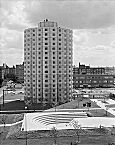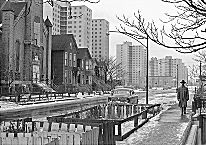| Entries |
| C |
|
Chicago Housing Authority
|
The initial goal of public housing was to provide decent housing for poor and low-income households. There have been two categories of public housing in Chicago: for families and for the elderly.

|

|
The racial segregation embodied in these developments was in compliance with federal policy (the “Neighborhood Composition Rule”), which required that the tenants of a housing development be of the same race as the people of the area in which it was located. Managers were selective in choosing among the thousands of families who applied for apartments. There had to be one employed breadwinner and the tenants had to behave according to prescribed rules.
During World War II, CHA was redirected to create housing for the workers in war industries. Two large projects had some units for black families, but, in addition, one very large project, Altgeld Gardens, built in Riverdale at the edge of the city with 1,500 units, was designed exclusively for black war workers. After the war, CHA provided several thousand units of temporary housing for veterans, in such forms as temporary plywood houses and Quonset huts. Abandoning the Neighborhood Composition Rule, CHA introduced a short-lived policy of racial integration, which precipitated a series of violent white-black confrontations.
When Congress passed the Housing Act of 1949, which provided substantial funding for public housing, CHA was ready with a map of proposed sites for projects to be built on open land throughout the city, but the city council rejected this map altogether. White aldermen rejected plans for public housing in their wards. CHA's policy thereafter was to build family housing only in black residential areas or adjacent to existing projects. This rejection explains the concentration of public housing in the city center on the South and West Sides.

|

|

|
After 1950, public housing began rapidly to deteriorate. Some buildings had serious design flaws. All buildings were subject to hard use and were badly maintained, which accelerated their deterioration. CHA managers stopped screening applicants and the socioeconomic mix of tenants changed, as the CHA was directed to accommodate all families who had been displaced by urban renewal, expressway construction, and other forms of slum clearance.
By the late 1950s, it was apparent that there were serious physical problems in the high-rise projects. Nonetheless, CHA continued to build high-rise projects in black districts until 1968, when the federal government stopped funding high-rise buildings for family housing. All told, CHA built 168 high-rise buildings with approximately 19,700 apartments for families.
In 1966 a group of tenants sued the CHA, alleging that the agency was perpetuating racial segregation by siting projects in the ghetto. In Gautreaux v. Chicago Housing Authority, a federal judge enjoined CHA from building additional family housing in black residential areas. He ordered the agency to build scattered-site housing elsewhere in the city. Thereafter the authority built no more than a handful of scattered-site dwellings.
Following the Gautreaux decision, almost all of the housing built by CHA was for elderly tenants, housing that could be built in white sections of the city. CHA erected its first project for the elderly in 1959, and between 1961 and 1976 the CHA built 46 developments, totaling 9,607 units.
Family high-rise projects continued to exhibit social problems and the buildings continued to deteriorate. In 1996, the federal department of Housing and Urban Development (HUD) took control of the CHA, on the grounds of mismanagement and poor performance. At about the same time, HUD introduced a radical change of policy, advocating demolition of failed high-rise buildings. Chicago demolished several high-rise buildings in 1996 and 1997, planning to redevelop those areas with a mix of public housing and housing for middle-income households. The CHA regained control from the federal government, as it undertook continued demolition and redevelopment.
The Encyclopedia of Chicago © 2004 The Newberry Library. All Rights Reserved. Portions are copyrighted by other institutions and individuals. Additional information on copyright and permissions.